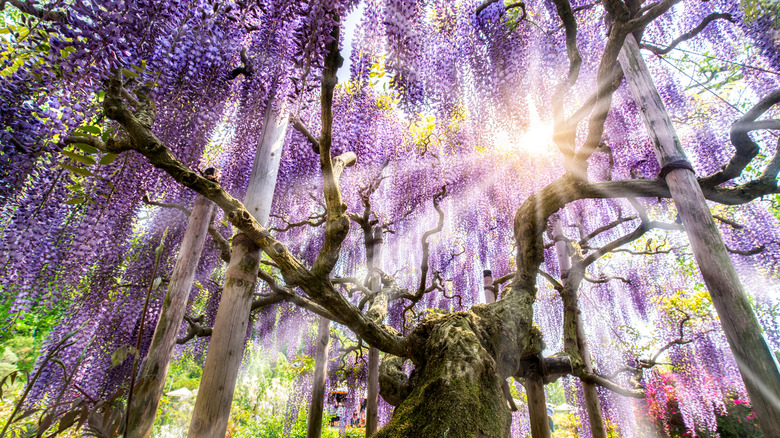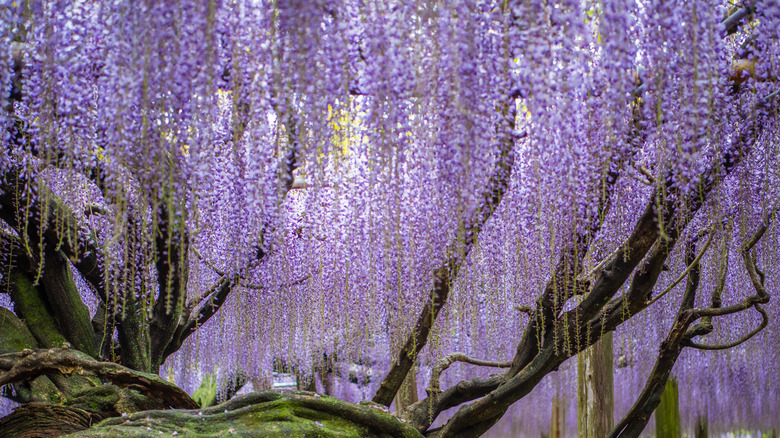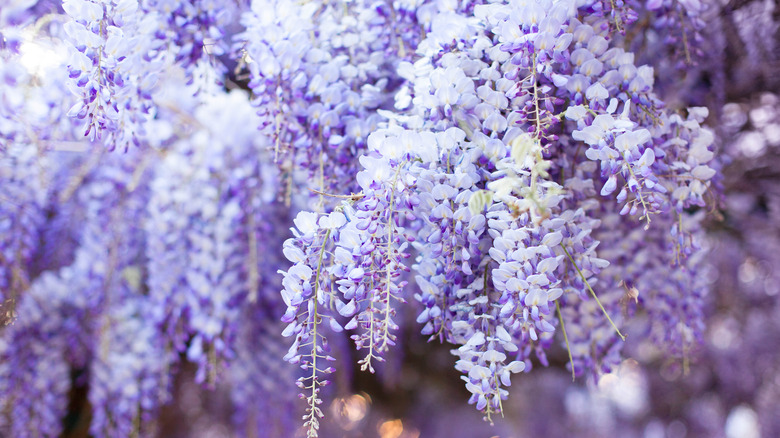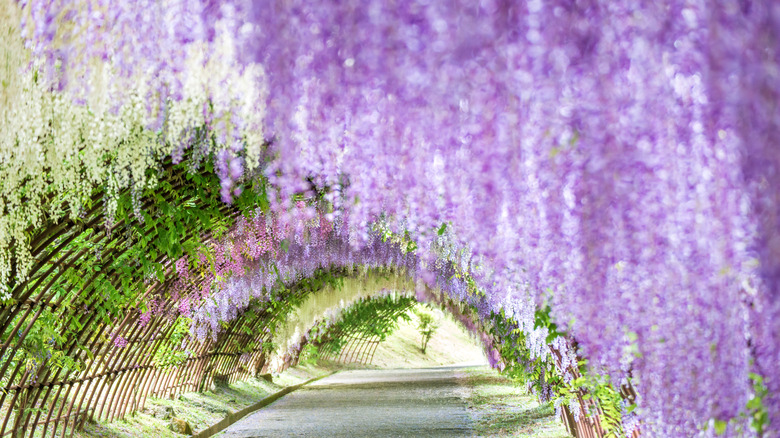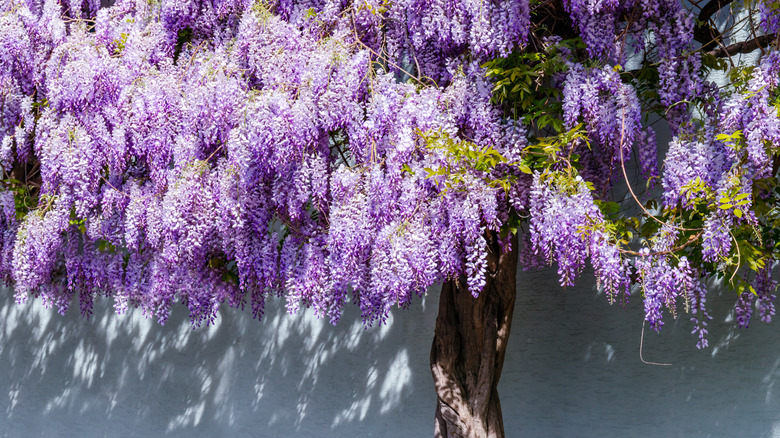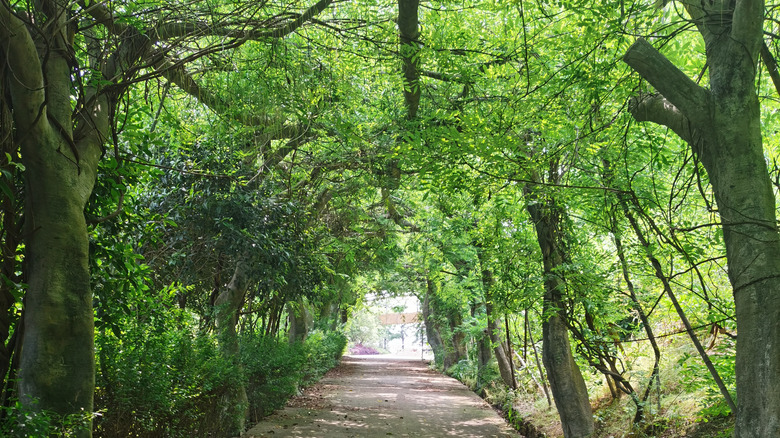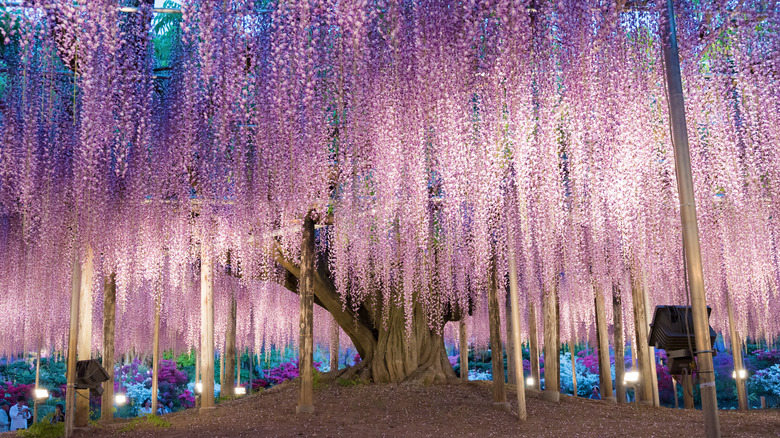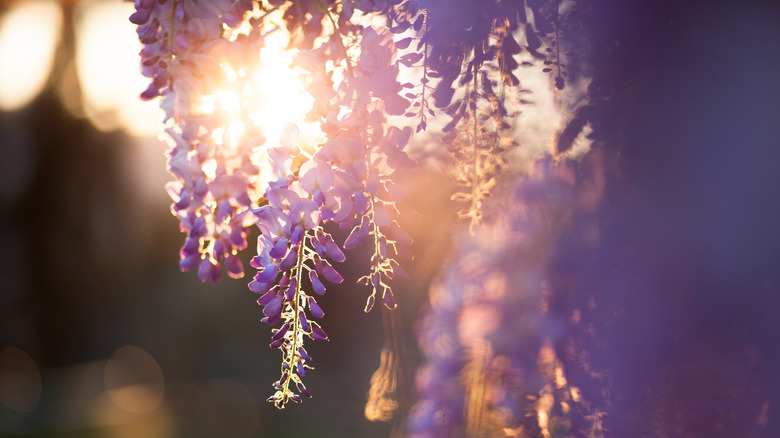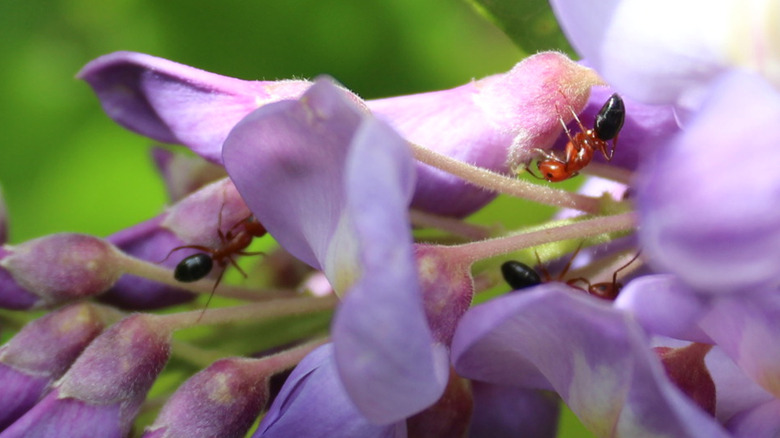How To Grow And Care For A Wisteria Tree
Wisteria is a gorgeous, magical-looking plant that sports unique, dreamy purple flowers, which dramatically hang from scraggly branches. Contrary to popular belief, wisteria, though often referred to as wisteria trees, is actually a vine, according to The Spruce. That being said, it often produces incredibly thick stems, which can easily be trained to grow into the shape of a tree (via White Flower Farm). Whether grown as a climbing vine or tree, wisteria is a show-stopping addition to any garden.
Wisteria is most commonly found in three varieties — American, Chinese, and Japanese. They can live for more than 50 years, and the Chinese version can live for a century. Despite their beauty and mystique, all three varieties are incredibly fast growers, and, as such, are considered invasive in many parts of the United States. For those allowed to grow vines, though, it is so worth it. With just a little bit of effort, you can have a unique and breathtakingly beautiful vine or tree in your backyard or garden.
How to use wisteria trees in garden
Before planting wisteria in your garden, there are a few things to take into consideration. As always, make sure you live in an appropriate climate to grow the plant. The Spruce says that wisteria grows best in USDA hardiness zones 5 through 9 and that it cannot sustain growth in climates hotter than this. Asian wisteria (Chinese and Japanese wisteria) is invasive in a large part of the United States, too, so either ensure it's safe to grow in your location or opt for an American variety.
Once you've decided on a variety, you'll then need to decide what shape you want to grow the vine. Wisterias can be grown into trees, but it takes a lot of patience, notes White Flower Farm. Doing so requires frequent pruning and staking while closely monitoring and manipulating the plant's growth pattern. Alternatively, you can grow it as a vine. Wisteria vines grow best on trellises and pergolas, or on any other similarly sturdy garden structure, according to Almanac.
Regardless of how you're planting it, wisteria has a tendency to grow wherever it can, so keep it away from homes and other buildings. While wisteria looks gorgeous growing on exterior walls, take care that it doesn't crack the structure. Wisteria also looks great grown in an archway in a garden, creating a romantic and magical feel. Other plants can grow alongside wisteria, but the vines may overtake them, so proceed with caution.
How to plant wisteria trees
The first step to growing either a large and awe-inspiring wisteria tree or a romantic and dreamy wisteria vine is to plant it in your garden. Wisteria can be found at both local nurseries and via online retailers in bare-root form. Alternatively, you can propagate a mature plant, which will be covered later. Planting should be done in either the spring or fall.
Once you have your wisteria ready to plant, White Flower Farm says to soak the roots in water for a few hours. In the meantime, prepare the planting site. Wisteria likes full sun (at least six hours a day) and well-draining soil. When digging a hole, make sure it's deep enough that the crown sits 1 inch under the soil and wide enough to fit the roots and allow some space to spread.
Take the plant out of its soak and hold the roots in the hole so that the crown sits an inch below the surface. Fill with soil and be careful not to create air pockets. Then, using more soil, create a rim at the edge of the filled hole in the shape of a basin, which will help direct water to the roots. Water thoroughly and, if growing as a tree, add a stake now. If you're treating it as a vine, wait for it to start growing and then direct it to a trellis, pergola, etc.
How to grow wisteria trees
As mentioned earlier, the most common and convenient way to grow wisteria is to purchase a bare root starter. However, wisteria can be grown both from mature vine propagation and from seed (via The Spruce). Growing from seed may take some time, but growing from a cutting may also be difficult, so don't expect this to be the easiest option.
Wisteria seeds can be found at garden centers, nurseries, and online retailers. Begin the process of germination once temperatures have consistently reached higher than or equal to 65 degrees. The night before seeding, soak the seeds in lukewarm water. That morning, fill some pots with a soilless dirt mix and sow the seeds an inch under the surface. Keep them moist and tent the pots for extra humidity. Once seeds germinate and start to grow a few inches, transplant to a larger pot or outside.
Stem cuttings should be taken in the late spring or early summer, and should be green, non-woody, at least 4 inches long, and have at least two sets of leaves and one node. Cut with clean and sterile shears. Then, as with the seeds, fill a pot with soilless dirt. Dip the raw end of the cutting in rooting powder and add to the pot. Water and tent for moisture retention. In a few weeks to a month, once roots grow, transplant them to a larger pot or outside.
How to care for wisteria trees
Although they appear quite high maintenance, caring for a wisteria tree or vine is easy. The biggest task involved in routine maintenance is pruning, which needs to be done regardless, but especially for those wanting their wisteria to grow into a tree.
As covered earlier, wisteria prefers lots of sunlight and should receive at least six hours of full sun a day. It also needs well-draining and fertile soil, notes Almanac. Soil can be made more fertile with compost, which can be added to the base of the plant annually in the spring. Mulching the plant in the spring will also help it self-regulate its moisture levels and prevent weeds. Wisteria only needs to be watered during dry spells, or when there is less than an inch of rain a week.
If healthy, wisteria trees will grow both up and out, so references to branch length won't necessarily be equal to height. Typically, these fast-growing trees can extend 10 feet or more annually until they reach a maximum height of 30 feet (via Rooting For Blooms). For those with smaller spaces, dwarf varieties will top out closer to 10 feet high, and there are 6-foot cultivars that will fare well in containers, notes Gardenia.
Why wisteria won't bloom and what to do
For all the hope and hype of a gorgeously blossoming wisteria tree, it would be a bit heartbreaking if yours showed no color at all come springtime. Improper pruning and insufficient watering are potential reasons for this sad affair, according to Gardening Etc., both of which can be easily tended to. First, understand that wisteria trees will live for a long time but will not flower on old wood. That means new growth is essential each and every season. Pruning twice a year is your best bet for stimulating shoot development — aim for late winter and the middle of summer. Regarding watering, additional hydration during the hottest months of the year (July through September) will go a long way to keep your tree healthy. Buds will already be forming for the following season at this time, so in essence, you need to think well in advance for next year's blooms.
Another issue that could negatively affect your flowers is bud drop from damage incurred during a late frost. If you live in a cold climate and have yet to plant your tree, consider finding a location that offers shelter from the elements. Planting it in the middle of the yard might expose it to harsh winds and lashing rains. Otherwise, you can try covering the tree anytime you suspect extremely low temperatures. Just remember to uncover it in the morning so the tree receives full sun exposure and can warm up. If you still experience issues, you can also add a phosphorus-rich soil amendment — either in the form of blooming fertilizer, bone meal, or rock phosphate. This should help your plant create new shoots.
Wisteria tree varieties
While wisteria is often lumped into just two categories — American and Asian — there's actually quite a vast range of species — an estimated total of 10 or so varieties, according to Britannica. While the plant mostly just originates from the aforementioned continents, and while it's important to distinguish the two for potential invasiveness, it is interesting to learn about the difference between varieties. Here are just a few, courtesy of Gardenia:
-
Wisteria macrostachya: The Kentucky Wisteria or Blue Moon Kentucky Wisteria is an American species and bears much lighter lavender, almost white flowers.
-
Wisteria floribunda: This species, referred to as Japanese Wisteria, is one of the most popular of the genus, and its purple flowers bloom well into the fall season, unlike other varieties.
-
Wisteria frutescens: This is another American variety, perhaps the most popular next to the Japanese Wisteria, and it has delicate, more understated blue-toned purple flowers.
-
Wisteria sinensis: This species is most commonly referred to as the Chinese Wisteria and is much bluer toned than its relatives, as well as being a favorite food for bees.
-
Wisteria brachybotrys: Also known as Wisteria venusta or Silky Wisteria, this Asian variety grows either white or very light purple flowers that turn a lovely golden shade in the fall.
Are wisteria trees toxic?
Despite its beauty, all parts of wisteria are quite toxic to both humans and animals (via Almanac). This is due to two substances — lectin and wisterin. When ingested by either cats or dogs, these substances can cause diarrhea, vomiting (potentially with blood), and depression, according to the ASPCA. If you suspect your pet has ingested any part of a wisteria plant, seek medical attention immediately. You should also bring with you the part of the plant that they ate, as some parts are more toxic than others.
While there aren't many serious cases of lectin or wisterin poisoning in humans, the plant should still be avoided, and children should be monitored when playing next to it. Science Direct notes that eating the plant can result in gastrointestinal irritation (vomiting, diarrhea, stomach pain), oral irritation (burning), and other symptoms like vertigo, confusion, fainting, and general weakness. While these effects are not reported to last longer than two days, it is still highly recommended that you consult a poison control hotline or medical professional after ingestion. You should always remove the plant's seed pods after flowering as well, as this is the most toxic part. Dead or fallen leaves and flowers should also be regularly cleaned up and disposed of.
Common pests and diseases with wisteria trees
As mentioned above, wisteria trees are toxic to animals, so it's unlikely that you'll have to worry about any of them chewing on the leaves of your prized specimen. If you're trying to figure out the culprit to any noticeable damage from munching, look to insects, caterpillars, and birds instead, as per Rooting For Blooms. Birds are most likely to go for buds and blossoms as they try to eat any insects present; caterpillars love the leaves. One caterpillar to look out for, in particular, sports a brown head atop a green body. Someday it will become a beautiful skipper butterfly, but in the meantime, it's likely to make lunch of your tree's foliage.
Aphids are a pesky breed of insect to manage. Their damage (when severe) will result in leaves that curl and turn yellow, or overall stunting of growth for the entire tree (via the National Pesticide Information Center). Aphids leave a residue called honeydew in their wake. It might have a cute name, but it's a very sticky and problematic waste product. Unfortunately, honeydew is full of sugar, which guarantees a line of ants marching up the tree trunk. Honeydew further creates an environment suitable for fungi looking for a place to settle and grow a family. The final nail in the coffin regarding an aphid infestation is that these pests don't just encourage favorable conditions for diseases; they actually inject those diseases directly into the tree's leaves and stems as they feed on the juice.
